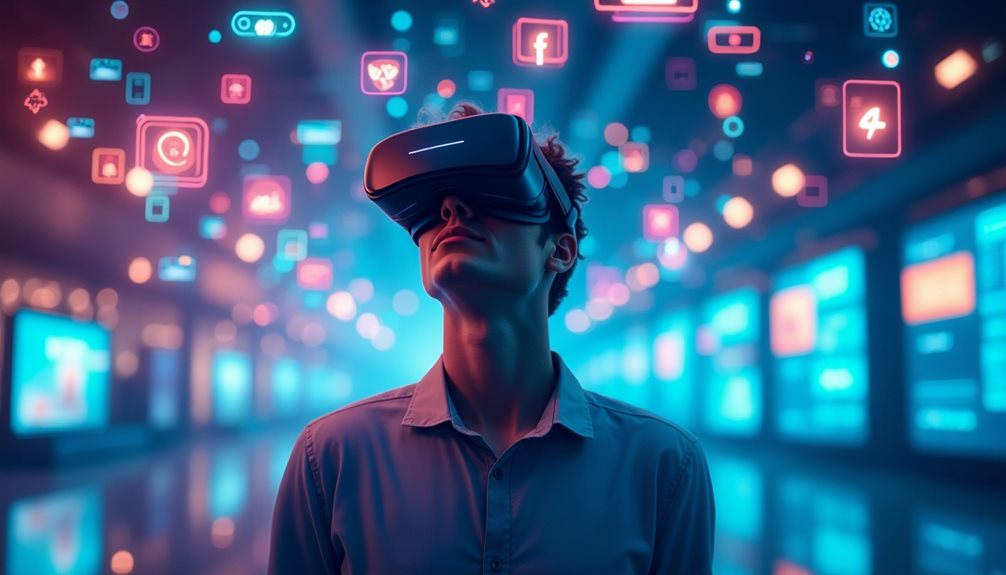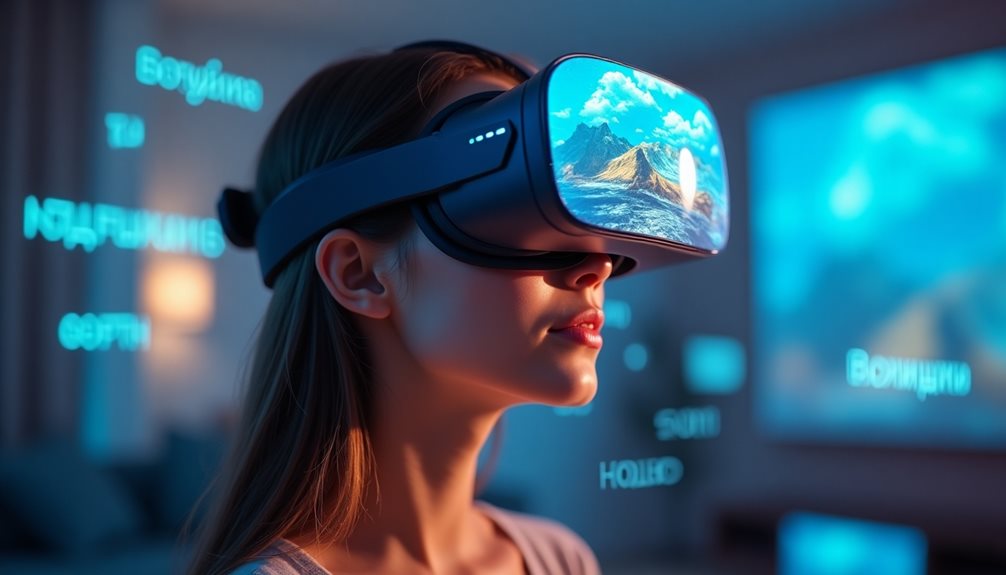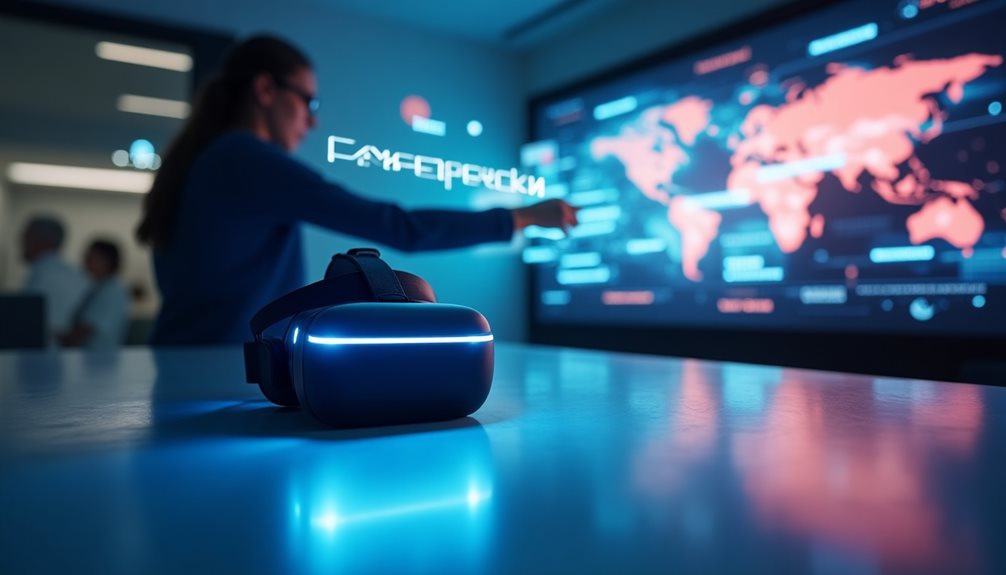![]()
Table of Contents
ToggleUnderstanding Virtual Reality (VR)

Virtual Reality (VR) represents a transformative technology that immerses users in digitally created environments, simulating real-world experiences through advanced hardware and software.
This innovation facilitates the exploration of virtual domains, offering unprecedented opportunities for interaction and engagement. Users experience sensory immersion, where visual, auditory, and tactile stimuli combine to create a convincing sense of presence within these digital environments.
VR applications span various fields, from gaming to education and therapy, empowering individuals to transcend physical limitations. As creators design increasingly sophisticated environments, the potential for personal freedom and creative expression expands, inviting users to engage in experiences that challenge conventional boundaries.
Ultimately, VR signifies a paradigm shift in how individuals perceive and interact with reality.
Key Terms in Augmented Reality (AR)
Augmented Reality (AR) enhances the real world by superimposing digital information and images onto physical environments, creating an interactive layer that complements reality. Key terms in AR facilitate understanding and application, enabling users to navigate this innovative technology effectively.
- Augmented Reality (AR): Technology overlaying digital content (images, animations, information) onto the real world.
Example: Pokémon Go shows virtual Pokémon in real locations. - Marker-Based AR: Requires a specific image or object (marker) for AR content to appear.
Example: Scanning a QR code or picture to reveal a 3D model. - Interactive Experiences: Activities where users interact with both digital and physical elements at the same time.
Example: Trying on virtual clothes or using painting apps in AR. - Markerless AR: Uses GPS, camera, or sensors instead of a physical marker to display digital content.
Example: Snapchat face filters that work without scanning anything. - Heads-Up Display (HUD): A transparent display showing data without blocking your view of the real world.
Example: Navigation directions projected onto a car windshield. - Spatial Mapping: Mapping the physical environment to accurately place digital objects in real space.
Example: Using an app to see how virtual furniture would look in your actual room.
Russian Terms for Augmented Reality
| Russian (Cyrillic) | Phonetic (English) | English Definition |
|---|---|---|
| дополненная реальность | dopolnennaya real’nost’ | augmented reality |
| маркер | marker | marker |
| маркерная AR | markernaya AR | marker-based AR |
| взаимодействие | vzaimodeystviye | interaction |
| интерактивный опыт | interaktivnyy opyt | interactive experience |
| безмаркерная AR | bezmarkernaya AR | markerless AR |
| пространственное отображение | prostranstvennoye otobrazheniye | spatial mapping |
| дисплей с наложением информации | displey s nalozheniyem informatsii | heads-up display (HUD) |
| цифровой объект | tsifrovoy ob’yekt | digital object |
| дополнение | dopolneniye | overlay |
These terms will help you discuss and understand AR technology both in English and Russian.
Immersive Environments in VR
Immersive environments in virtual reality (VR) are transforming the way people interact with digital content by blurring the line between the virtual and the real. The foundation of this transformation is a sense of presence—the feeling that you truly “exist” inside a virtual world, rather than just observing it from the outside.
Core Elements of Immersion
1. Multisensory Integration
- Soundscapes: Realistic audio is crucial. Spatial audio technology makes sounds appear to come from specific directions, adding depth and realism. For example, footsteps echo in a cavern, or birds chirp from a distant tree, helping users orient themselves within the space.
- Haptic Feedback: Tactile sensations, delivered through specialized controllers or gloves, allow users to “feel” textures, impacts, or resistance. Picking up virtual objects or feeling subtle vibrations during an explosion increases the perceived reality of the environment.
- Visual Fidelity: High-resolution textures, dynamic lighting, and lifelike animations all play a role in convincing the brain that what it sees is real. The more accurately these visual cues mirror reality, the stronger the immersion.
2. Interactive World Design
- Dynamic Interactions: Objects in VR often behave as their real-world counterparts do. You can open doors, manipulate tools, or even scribble on virtual surfaces. These interactions respond directly to user movements and decisions.
- Expansive Landscapes: Developers craft vast environments that users can explore freely—cityscapes bustling with activity, peaceful forests with subtle wildlife, or alien planets with strange geology. This freedom enhances the sense of discovery.
3. Adaptive and Responsive Systems
- AI-driven Scenarios: Non-player characters (NPCs) and environments adapt to user actions. For instance, virtual shopkeepers might engage in conversation based on previous choices, or weather systems change dynamically as you move through different regions.
- Procedural Generation: Some VR experiences use algorithms to generate terrain, buildings, or challenges on the fly, ensuring that each user’s journey is unique.
Psychological and Creative Impact
Immersive VR environments can trigger strong emotional responses—wonder, excitement, fear, or tranquility—depending on the context. Because the brain processes these environments as real spaces, users may feel genuine connections to virtual places and characters.
These environments are also powerful tools for creativity and collaboration:
- Art and Design: Artists use VR to sculpt, paint, and design in three dimensions, walking around their creations as if they were physical objects.
- Team Collaboration: Teams from around the world can meet “face-to-face” in shared VR spaces, manipulating virtual prototypes or brainstorming ideas as if they were in the same room.
Redefining Digital Boundaries
The ongoing evolution of immersive VR environments is not just an enhancement of existing digital experiences; it’s a reimagining of what is possible. As hardware improves—with lighter headsets, better motion tracking, and more natural input devices—immersive environments will continue to become more convincing and accessible.
Immersive environments in VR are reshaping how we play, learn, create, and connect. They offer new forms of storytelling and interaction that go beyond traditional media, inviting users to step inside digital worlds and make them their own.
Essential Hardware for VR and AR
Essential hardware plays a critical role in the functionality and effectiveness of VR and AR experiences. Head mounted displays (HMDs) serve as the primary interface, delivering immersive visuals directly to the user’s eyes while tracking head movements to enhance realism. These devices typically incorporate high-resolution screens and advanced optics to create a lifelike environment.
Complementing HMDs, motion controllers enable intuitive interaction within virtual environments, allowing users to manipulate objects and navigate seamlessly. These controllers often feature precise tracking capabilities, ensuring responsiveness and accuracy in user input.
Together, head mounted displays and motion controllers form the backbone of VR and AR systems, empowering users to explore and interact with digital domains, thereby fostering a sense of freedom and agency in their experiences.
Virtual Reality (VR) and Augmented Reality (AR) rely on specialized hardware to provide users with realistic and interactive experiences. For English speakers learning Russian, understanding key components and related vocabulary will deepen both technical and language skills.
Key Components
1. Head Mounted Displays (HMDs)
Head mounted displays are worn on the head, similar to goggles or helmets. They contain screens positioned in front of the eyes and use sensors to track head movement. This allows users to look around virtual spaces as if they were really there. Popular examples include the Oculus Quest, PlayStation VR, and HTC Vive.
In Russian:
- Шлем виртуальной реальности (VR headset)
2. Motion Controllers
Motion controllers are hand-held devices that track the movement of your hands. They often have buttons, triggers, and touch-sensitive surfaces so you can pick up objects, press virtual buttons, or even draw in the air.
Examples:
- Oculus Touch controllers
- PlayStation Move
- Valve Index controllers
In Russian:
- Контроллеры движения (motion controllers)
3. Tracking Systems
Tracking systems use cameras or sensors to monitor the position of your head, hands, or even your full body in space. This tracking is crucial for making movements in the virtual world feel natural.
In Russian:
- Система отслеживания (tracking system)
4. Additional Hardware
- Haptic Feedback Devices: Let you “feel” interactions through vibrations or pressure.
- External Sensors: Cameras or base stations that help track your movements.
- AR Glasses/Smart Glasses: Lightweight wearable devices for overlaying digital content onto the real world.
Key Russian Terms Table
| Russian (Cyrillic) | English Phonetic | English Definition |
|---|---|---|
| Шлем виртуальной реальности | shlyem virtual’noy real’nosti | VR headset |
| Контроллеры движения | kontrolery dvizheniya | Motion controllers |
| Система отслеживания | sistema otslezhivaniya | Tracking system |
| АР-очки | AR-ochki | AR glasses |
| Виртуальная реальность | virtual’naya real’nost’ | Virtual reality |
| Дополненная реальность | dopolnennaya real’nost’ | Augmented reality |
| Высокое разрешение | vysokoye razresheniye | High resolution |
| Сенсор | sensor | Sensor |
| Гаптическая обратная связь | gapticheskaya obratnaya svyaz’ | Haptic feedback |
| Оптика | optika | Optics |
| Пользователь | pol’zovatel’ | User |
Using this vocabulary, learners can start to describe and discuss VR and AR hardware in Russian.
Software and Applications in VR
(Программное обеспечение и приложения в виртуальной реальности)
Virtual reality (VR) and augmented reality (AR) are not just about the hardware like headsets or controllers. The real magic happens because of the software (программное обеспечение, [proh-GRAHM-nah-yeh ob-yes-PEH-chee-neh-yeh]) and applications (приложения, [pree-loh-ZHEN-ee-ya]) that run on these devices. These programs create and control what you see and do in the virtual world.
How Software and Applications Enhance VR/AR
1. Interactive Simulations (Интерактивные симуляции)
These let users safely practice real-world tasks, like flying a plane or performing surgery, in a virtual space.
- Russian example:
- Интерактивная симуляция управления автомобилем ([in-ter-ak-TEEV-nah-ya see-myoo-LYA-tsi-ya oop-ra-VLYEN-ee-yem av-ta-mo-BEE-lem])
- English: Interactive simulation for driving a car
2. Educational Tools (Образовательные инструменты)
These programs make learning more engaging, letting students interact with 3D objects or explore historical sites virtually.
- Russian example:
- Образовательное приложение по биологии ([ob-ra-za-va-TEL-nah-ye pree-loh-ZHEN-ee-ye po bee-a-LOH-gee-ee])
- English: Educational biology app
3. Entertainment Experiences (Развлекательные приложения)
Games and storytelling apps allow users to play, explore, and immerse themselves in new worlds.
- Russian example:
- Виртуальная игра ([veer-too-AL-nah-ya ee-GRA])
- English: Virtual game
Common Russian Terms Related to VR Software and Applications
| Russian (Cyrillic) | Phonetic (English) | English Definition |
|---|---|---|
| виртуальная реальность | veer-too-AL-nah-ya ree-AL-nost’ | Virtual reality |
| дополненная реальность | da-POHL-nen-nah-ya ree-AL-nost’ | Augmented reality |
| программное обеспечение | proh-GRAHM-nah-yeh ob-yes-PEH-chee-neh-yeh | Software |
| приложение | pree-loh-ZHEN-ee-ye | Application/App |
| интерактивный | in-ter-ak-TEEV-ny | Interactive |
| симуляция | see-myoo-LYA-tsi-ya | Simulation |
| образовательный | ob-ra-za-va-TEL-ny | Educational |
| инструмент | in-stroo-MENT | Tool/Instrument |
| игра | ee-GRA | Game |
| пользователь | POL-zoh-vah-tel’ | User |
| интерфейс | in-ter-FEYS | Interface |
Through innovative VR software and AR applications, users are empowered to explore and interact with digital domains, expanding their freedom of experience and creativity in the digital landscape.
Common VR and AR Experiences

Virtual and augmented reality (VR and AR) are revolutionizing the way people interact with digital content by offering deeply immersive experiences. These technologies go beyond simply displaying information on a screen; they create interactive environments and overlays that engage users’ senses and attention in new ways.
Virtual Tourism
With VR, users can visit landmarks, museums, or natural wonders from anywhere in the world. Through 360-degree video or fully interactive 3D worlds, people can “walk” through the streets of Paris, explore Machu Picchu, or even journey to the surface of Mars—all from their living room. This approach is particularly valuable for those with physical limitations, budget constraints, or travel restrictions. Museums often employ VR to allow virtual access to exhibits, offering detailed close-ups and guided tours.
Interactive Gaming
Gaming remains one of the most popular uses of VR and AR. In VR games, players are transported into digital worlds where they can look around, move, and interact as if they are truly inside the game. This fosters a heightened sense of presence and often enables social play, where multiple users interact in shared environments. AR gaming, such as Pokémon GO, overlays digital objects onto the real world using a smartphone or AR headset, encouraging exploration and social interaction in physical spaces.
Educational Simulations
VR and AR are increasingly used in education for hands-on learning. Medical students, for example, can practice surgical procedures in a risk-free virtual setting, gaining experience before working with real patients. History students might explore ancient civilizations through VR reconstructions of archaeological sites. AR can overlay labels, translations, or interactive diagrams onto textbooks or lab equipment, making complex concepts easier to grasp.
Language Learning
Immersive environments are proving effective for language acquisition. For example, learners can join virtual Russian classes or converse with AI-powered avatars in simulated real-world scenarios—a café, market, or classroom—practicing vocabulary and pronunciation in context. Some platforms use AR to display translated text or phrases directly onto objects in the user’s environment, reinforcing word associations.
Remote Collaboration and Work
VR meeting rooms and AR-enhanced workspaces enable remote teams to collaborate as if they were in the same room. Participants can share 3D models, annotate designs in real time, and interact with data visualizations. This is especially valuable in fields like architecture, engineering, and design.
Healthcare and Therapy
VR is used for pain management, phobia treatment, and physical rehabilitation. Patients might be guided through calming virtual environments to reduce anxiety or participate in gamified exercises that make therapy more engaging. AR helps surgeons by overlaying critical information during procedures.
Retail and Shopping
AR apps let customers “try on” clothes or visualize furniture in their home before buying. Virtual showrooms offer a new way to browse products, combining convenience with interactivity.
Overall, VR and AR experiences are reshaping digital engagement by offering realistic simulations, practical applications for learning and work, and novel ways to connect with people and places around the world. As technology matures, the range and depth of these experiences will continue to grow.
Industry Applications of VR and AR
Innovations in virtual reality (VR) and augmented reality (AR) are reshaping the way businesses and organizations operate. Both technologies provide immersive and interactive experiences, changing how people learn, work, and play. Let’s explore their impact in several key sectors, along with useful Russian vocabulary for English speakers interested in this topic.
Healthcare Applications
Virtual and augmented reality have become powerful tools in healthcare. VR enables medical professionals to practice surgeries in a risk-free simulated environment, improving precision and confidence. AR can be used during actual procedures, overlaying digital information—like blood vessel maps—on a surgeon’s view. These applications help reduce errors and enhance patient outcomes.
Example:
A medical student can use VR to practice heart surgery multiple times before working on a real patient.
Gaming Industry
The gaming industry is one of the earliest adopters of VR and AR. With VR headsets, players step inside the game world, interacting with lifelike environments. AR games, such as Pokémon GO, blend digital elements with the real world by overlaying game characters onto the player’s surroundings via their smartphone camera.
Example:
A VR horror game can make players feel like they are actually inside a haunted house, increasing excitement and immersion.
Education
Education is being transformed by VR and AR through interactive simulations, virtual field trips, and 3D models that help students understand complex subjects. VR can simulate historical events or scientific phenomena, while AR can add interactive diagrams to textbooks.
Example:
A teacher uses AR to display a 3D model of the solar system in the classroom, letting students walk around planets and see their details.
![]()
Russian Terms Related to VR and AR
| Russian (Cyrillic) | Pronunciation (English) | English Definition |
|---|---|---|
| виртуальная реальность | veer-too-AL-naya re-AL-nost’ | virtual reality |
| дополненная реальность | da-POL-nen-naya re-AL-nost’ | augmented reality |
| симуляция | see-mu-LYA-tsiya | simulation |
| обучение | ob-oo-CHEN-ee-ye | training/learning |
| хирург | khee-ROORG | surgeon |
| игра | ee-GRA | game |
| образовательная технология | ob-ra-za-va-TEL-na-ya tekh-no-LO-giya | educational technology |
| взаимодействие | vzai-mo-DEY-stvi-ye | interaction |
| погружение | po-gruzh-EN-ee-ye | immersion |
| пользователь | POLZ-o-vah-teel | user |
| устройство | oos-TROYST-vo | device |
These terms will help you discuss VR and AR in Russian, understand articles or news on the topic, and communicate with Russian speakers interested in technology.
Future Trends in VR and AR
As advancements in technology continue to evolve, the future of augmented and virtual reality is poised to transform user experiences across various domains.
Future innovations are expected to focus on improved hardware capabilities, enabling more immersive and seamless interactions. Enhanced AI integration will personalize user experiences, adapting environments in real-time and providing tailored content.
Market predictions indicate a significant increase in the adoption of these technologies in sectors such as healthcare, entertainment, and education, leading to a more interconnected digital landscape.
Additionally, the emergence of 5G networks will facilitate lower latency and higher bandwidth, further enhancing user engagement.
Collectively, these trends suggest a dynamic shift towards more immersive, interactive environments that empower users to explore vast possibilities.
Learning Resources for VR and AR Vocabulary
The evolution of augmented and virtual reality technologies necessitates a thorough understanding of the associated vocabulary to fully engage with their potential applications.
To facilitate this learning, several innovative resources are available that focus on vocabulary acquisition in these fields.
- Online Learning Platforms: Websites offering specialized courses on VR and AR terminology, enhancing comprehension through structured content.
- Interactive Vocabulary Exercises: Engaging activities that reinforce terms through practical application, ensuring users can contextualize their learning.
- Mobile Applications: Tools designed for on-the-go learning, providing users with quick access to vocabulary lists and quizzes, promoting continual engagement.
These resources empower learners to master the vocabulary essential for traversing the expanding domains of virtual and augmented reality.
Frequently Asked Questions
What Are the Differences Between VR and AR Technologies?
Virtual Reality applications create immersive, computer-generated environments, while Augmented Reality experiences overlay digital elements onto the real world. This distinction highlights their unique capabilities, catering to diverse user needs and experiences in innovative technological landscapes.
Can VR and AR Be Used for Education?
The integration of VR and AR technologies in educational applications enhances immersive learning experiences. These innovations facilitate interactive environments, fostering deeper understanding and engagement, ultimately empowering learners to explore complex concepts through dynamic, experiential methodologies.
How Do I Choose Between VR and AR for My Project?
Choosing between VR and AR involves evaluating user experience and aligning it with project goals. VR offers immersive environments, while AR enhances real-world interactions, thereby informing a decision based on intended engagement and educational outcomes.
What ARe the Health Risks Associated With VR and AR Usage?
Health risks associated with VR and AR usage include eye strain from prolonged exposure to screens and motion sickness triggered by disorientation during immersive experiences, potentially impacting user comfort and overall engagement in these technologies.
ARe There Free Resources to Learn VR and AR Vocabulary?
Numerous free online courses and vocabulary flashcards are available, enabling learners to acquire essential terminology effectively. These resources provide an accessible path to mastering complex concepts, fostering independence and enhancing comprehension in emerging technological fields.



